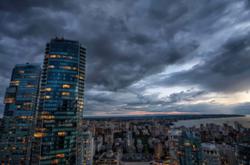[Editor’s note: Tyee education and youth reporter Katie Hyslop recently spent two weeks in British Columbia’s ruggedly beautiful, resource-rich and jobs-poor northwest, exploring both the promise of gas, oil and other mega-developments and their perils with dozens of teenagers and young adults. Find her series of reports here.]
There’s a sharp change leaving the Bulkley Valley for the drive to Prince Rupert.
It was hot and sunny when I left Smithers in mid-August after a week of hearing from young people in the Bulkley Valley what they thought about mega projects like LNG and bitumen pipelines. The car air conditioner stayed on full blast for the next four hours.
But in the City of Rainbows, so nicknamed for its 240 days of annual precipitation, it was overcast and cool. Wisps of fog clung to the treed mountainsides.
And while my sampling method was admittedly unscientific, the differences seemed to carry through to the attitudes youth living on the coast had toward megaprojects in their region.
Not one of more than two dozen young people I met over several days in Prince Rupert, Kitimat and the Haisla nation’s Kitamaat Village supported the diluted bitumen pipeline that Calgary’s Enbridge Inc. wants to build from Alberta. But many voiced their support for LNG — which earned only one or two tepid endorsements in the Bulkley Valley — as long as it’s “done right.”
Nineteen year-old Jacob Gruber, working for the summer at his dad’s games and electronics store, offered the first really positive view of LNG I’d yet heard on my trip. He’ll support the industry “as long as they can prove that they’re not going to ruin everything.” So far he feels developers are “doing all the tests they need to.”
He says he’s gotten a lot of his information about LNG from his mom, who works for the Prince Rupert Port Authority. The authority’s website lists four LNG projects in its “Future Growth” section.
But he’s also heard from indigenous community representatives who spoke to his Northwest Community College class last year. “It seems a lot of them have that same opinion. They want it, but they want it done properly,” Gruber said. “There were a couple who were very against it, but they couldn’t back it up. They had very circular arguments.”
Stephanie Hill’s arguments against megaprojects are from experience. Originally from Hartley Bay, 145 kilometres south of Prince Rupert, the 27-year-old saw firsthand how even a relatively small hydrocarbon spill could impact her community.
When the Queen of the North ferry sank near Hartley Bay in 2006, the Gitga’at community’s rescue of its passengers earned a Governor General’s Award; but the sinking released diesel fuel that ruined their fishery.
“We couldn’t go cockle digging,” Hill recalled. Only this year, “for the first time in years we were finally able to go out seaweed picking again, and it wasn’t even that great.” More leaks, she fears, “could affect the way that we live, that our ancestors have been living forever, and we don’t want that taken away from us.”
And while spilled LNG may not be as persistent as diesel, Hill notes that “not everyone’s guaranteed a job through LNG. You’ve got to go to school, you’ve got to get certificates — who’s going to pay for that?”
Need hard to miss
The economic need here is hard to miss. A walk down one of downtown Prince Rupert’s busiest streets, Third Avenue West, is like a step back in time, tinged with nostalgia and a bit of sadness. It’s clear from the dated storefronts and disrepair that it’s been 30 years since downtown saw a new building. From McBride Street to Fraser Street, Third Avenue has nearly 100 storefronts. A score are vacant.
The small city values its heritage. The nearly 100-year old Capitol Theatre still stands, kitty-corner to the art deco city hall, still in use after 80 years.
But the Capitol’s not a theatre anymore. Instead it houses a hearing clinic, the Prince Rupert Economic Development Office, and Pacific Northwest LNG. West Coast LNG is two doors down, next to one of four gyms along the one-kilometre stretch that also boasts half a dozen thrift, dollar and bargain shops.
At its peak in the early 1990s, the city was home to nearly 20,000 people. Thanks to lumber disputes with the United States and a declining fishery, that’s down to 12,000 now. Rupert’s biggest employer is the 11-year-old container port, connected to rail lines that reach the continent’s interior.
But things could change if LNG comes through. Eight of 23 LNG projects that have been proposed for B.C. envision locating close enough to Prince Rupert to give the city an economic boost.
And the area’s schools are already shaping what they hope will be their future workforce.
Thirteen-year-old Joey Tapper was playing Pokémon Go near the waterfront when we met. He wasn’t super familiar with the details of LNG, but his Prince Rupert Middle School has already taken students to a couple of job fairs featuring the subject.
“It was jobs that are available to people in Prince Rupert,” he explained. “Mostly trades.” Even at his age, Tapper’s aware of the need for jobs. His own dad, he says, worked on the recent modernization of the Rio Tinto Alcan smelter in Kitimat.
Tyler Winther, 20, was on lunch break from the last day of a summer job as a plumbing apprentice. A few years ago he attended a public demonstration of steps LNG companies say they’re taking to protect the environment along with his Northwest Community College biology class.
Any resource industry, including the fishery and the port, is a risk to the environment, he argued. “Most people are willing to accept [LNG], as long as it has some terms and conditions attached to it. I think [risks] can be minimized to the point that it’s acceptable.”
Winther, who has his first year millwright ticket, tells me he felt pressured to go into trades during his time at Prince Rupert’s Charles Hays Secondary School. And echoing a complaint I heard in Smithers, he said that Northwest [Community College] has cut its academic programs. “So it’s becoming more like a trade school, which is good for the town because we do need trades. But it’s hard for those who [are] academically inclined to find something.”

Booms carry risk too
Alec Broeders is a young man of many trades. The 24-year-old seine fisherman has training in carpentry, mechanics and welding, all of which could find him work on a megaproject like LNG or Northern Gateway. But Broeders, who’s originally from the oil town of Dawson Creek, B.C., has seen the destruction resource megaprojects can cause, and doesn’t want any part of them.
“I’m looking at the environmental effects: what if that line breaks? If that bursts and destroys a mountain side?” He’d like to see the province move away from oil and gas entirely, to renewables like solar and hydrogen technologies. “We need work, but there’s other work out there.”
I meet Sydney Barker, 20, outside the Fresh Onion Café & Catering where she works. She’s originally from Kitkatla, a Tsimshian village a 45-minute ride by small plane from Rupert that depends on the fishery for economic, nutritional and cultural sustenance.
There, she insists, “everyone’s against [LNG]. The ocean’s what sustains us. And the second there’s an oil spill, it’s all gone, it’s gone for a very long time. And it’s such a hard thing to clean up or even attempt to clean up.”

Like many youth I’d met in the Bulkley Valley, Barker viewed LNG and oil development as equivalent, even though the two pose different risks.
Crude oil is harder to clean up. But LNG facilities have exploded historically in Cleveland, in this century in the Algerian port of Skikda, and just two years ago in Plymouth, Wash.
Kitimat — and Kitamaat: warmer to LNG
Kitimat — another two-hour drive southeast of Prince Rupert — shares its story of a dwindling population and stumbling local economy. A town of over 10,000 in 2001, its population hit the low 8,000s in 2010, the year that West Fraser closed its Eurocan mill there and put another 535 people out of work.
The province says the population will go back over 10,000 this year, though it’s unclear where they’ll come from, industrial development or the increasing number of seniors retiring to the picturesque region. (Enticing them is part of Kitimat’s Community Plan to grow without new industrial job creation.)
The region’s biggest employer is the Rio Tinto Alcan aluminum smelter, which recently completed a $4.8-billion modernization. At its peak, the work employed 3,000 people — 1,000 of them locals. Today the smelter employs close to 1,400.
But the district of Kitimat anticipates $18 billion in local investment if all nine megaprojects contemplated for here are approved. Most are LNG-related, but they include Enbridge’s Northern Gateway oil and “diluant” pipeline.
The money could create thousands of short-term construction and hundreds of long-term operational jobs. And the young people I met in Kitimat and nearby Kitamaat Village are eager for some of them. But not all.
A sharp distinction
“I am pro-LNG,” said Katica Botz, 27. “We do need jobs, and from what I’ve read or the debates I hear, it’s not affecting the environment in our area too much.” She associates environmental arguments against LNG with people who don’t want to see the community change.
But Botz is against the Northern Gateway pipeline and its related plan to ship diluted bitumen by tanker to Asia. “I don’t feel that an oil spill is worth any amount of money.”
I hear that line drawn again and again during my conversations.
Christina Thomas, 23, is concerned about the environment. But the young mom, who was carrying her toddler Abigail when we met, says that “if they just go through it the right way and do it properly, it will be good for people here who need jobs.”
But not all the impacts from a megaproject boom would be positive for her family, she fears. An influx of jobs could also raise rents, hurting low-income families like hers. Almost 20 per cent of Kitimat households made less than $30,000 in 2011.
“I remember looking at a [three-bedroom] townhouse where they wanted a $1,000 a room,” she said. “And that’s not including utilities. And I think if the LNG does come through, that should be one of the topics [discussed], because there are families out here who can’t afford that, and they’re living paycheque to paycheque.”
Kailee Gardiner, 19, was against LNG until she got a summer job with LNG Canada this year. “I was pretty uneducated,” she said. “But once you get the information, I think that LNG is one of the safer natural resources, so I’m all for it now.” She admits she doesn’t know much about fracking, the process used to extract most gas, “but compared to oil I think it’s very safe.”
Gardiner lives in Kitimat, but she’s a member of the Haisla nation, based a 20-minute drive down the road in Kitamaat Village. Home to 700 of the roughly 1,700-members of the Haisla nation, Kitamaat is counting on LNG. It has leased land to Chevron and Woodside, an Australian oil and gas company that’s partnered with Chevron for a proposed LNG liquefaction facility on Haisla land, and the village could also benefit from jobs in Kitimat-based LNG projects.
Rebecca Schuss, 21, was born and raised here, but recently returned after earning a psychology degree in Toronto to work for Tamitik Status of Women down the road in Kitimat. Speaking with me after enjoying “Indian tacos” — taco fixings on fried bread — at an elders luncheon in Kitamaat Village, Schuss said she sees the negative impact unemployment has on families.
“For me, I feel environment comes before jobs,” she said. “But at the same time, I’ve never been in a place where I was so in need. That would change my perspective.”
“My eyes have been opened to how many people around us are in that state. And I’m sure that they would take a job if they could get it.”
But like so many others Schuss distinguishes Enbridge’s Northern Gateway pipeline, which her own mother, a Haisla council member, stood against, from LNG, which she believes is safer.
So does Dustin Gauchier, 33, who claims he’s done the research to back it up. A “jack-of-all-trades” at the Village’s seniors’ centre, Gauchier describes himself as a “conspiracy theorist” who’s looked closely at what oil spills do to water and land. By contrast, he insists, “The hazards from LNG are minimal. There’s always a chance of a leak. But compared to Enbridge, it won’t last a lifetime.”
“I don’t know what the half-life of bitumen or crude petrol is, but it’s been around for millions of years, so it’s not breaking down. The Exxon Valdez [oil spill in Alaska] happened in what, ’88? You can go up there [and] flip rocks on the beach and it’s still underneath the rocks.”
Twenty-eight-year-old Hilary Robinson takes LNG over oil for the same reason. “[Oil’s] a cause for disaster, and it’s just a matter of time,” said the young mom and lifelong Kitamaat Village resident. “I grew up around here, and seafood is such a huge part of my diet and my children’s.”
Robinson has work, but supports LNG for its jobs. “We can go back to having a dead town like we did before Rio Tinto came,” she said, “or we can continue to grow.”
In fact, however, the choice may end up being taken away.
All the promised LNG projects are on hold, as Asian demand for gas has dropped amid a glut of competing supplies from other producing regions. Regulatory approval for Enbridge’s pipeline was suspended when it failed to meet conditions in time to begin work on the project.
Like other promised resource booms, this one too may fade into the coastal mists, easing the anticipated environmental threats. But that still leaves young people in the north in limbo, siphoned towards trades jobs that never materialized. Wondering whether the northwest’s future holds a place for them to be financially secure in their hometown. ![]()
Read more: Labour + Industry
















Tyee Commenting Guidelines
Comments that violate guidelines risk being deleted, and violations may result in a temporary or permanent user ban. Maintain the spirit of good conversation to stay in the discussion.
*Please note The Tyee is not a forum for spreading misinformation about COVID-19, denying its existence or minimizing its risk to public health.
Do:
Do not: